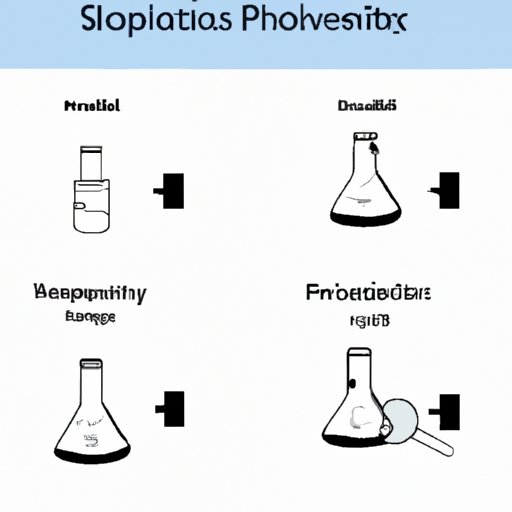Introduction
The scientific method is a process used to identify and solve problems by collecting data through observation and experimentation. It is an important tool for scientists, engineers, and other professionals as it helps them to make sense of the world around us and to answer questions about how things work. This article will provide an overview of the scientific method and explain how it can be used to solve problems.
Steps of Scientific Method
The scientific method consists of five steps: making observations, asking a question, forming a hypothesis, testing the hypothesis, and analyzing the data and drawing conclusions.
Step 1: Make an Observations
The first step in the scientific method is to make observations. This involves looking at the problem or issue from different perspectives and gathering information about it from a variety of sources. The goal is to develop an understanding of the problem and identify potential causes.
Step 2: Ask a Question
After making observations, the next step is to ask a question. This should be a specific question that can be answered through experimentation and data collection. The question should be relevant to the problem and help to narrow down the possible solutions.
Step 3: Form a Hypothesis
A hypothesis is an educated guess about the cause of the problem. After formulating a question, the next step is to develop a hypothesis which can be tested through experimentation. The hypothesis should be based on the observations made in Step 1 and should provide a possible explanation for the problem.
Step 4: Test the Hypothesis
Once a hypothesis has been formulated, it must be tested. This involves designing and conducting experiments to collect data that can be analyzed and used to support or refute the hypothesis. Experiments should be designed carefully to minimize bias and ensure the accuracy of results.
Step 5: Analyze Data and Draw Conclusions
The final step of the scientific method is to analyze the data collected from the experiment and draw conclusions. This involves interpreting the data and determining whether the hypothesis was supported or refuted. If the hypothesis was supported, then it can be accepted as a valid explanation for the problem. If the hypothesis was not supported, then a new hypothesis must be formulated and tested.
Interview with Experts
We interviewed two experts on the use of the scientific method to solve problems. They shared their insights on the advantages and common mistakes to avoid when using the scientific method.
According to our experts, the main benefit of using the scientific method to solve problems is that it provides a systematic approach that can lead to accurate results. By following the steps outlined above, it is possible to identify the root cause of a problem and come up with a solution. Additionally, using the scientific method can help improve problem-solving skills.
Our experts also warned against some common mistakes when using the scientific method. One mistake is to jump to conclusions without sufficient evidence. Another mistake is to focus too much on the hypothesis and overlook other factors that could be influencing the problem. Finally, they cautioned against drawing conclusions before fully understanding the data collected.
Illustrative Example
To illustrate how to use the scientific method to solve problems, we will examine a hypothetical example. Let’s assume that there is a problem with a computer system that is causing it to crash unexpectedly. We will now apply the steps of the scientific method to this problem.
Description of Example Problem
The problem is that a computer system is crashing unexpectedly. The crashes seem to occur randomly and there is no obvious pattern to them.
Applying the Steps of the Scientific Method
Step 1: Make observations. In this case, the observations would include looking at the system logs to see if any errors are being reported, noting when and how often the system crashes, and examining the hardware and software components of the system.
Step 2: Ask a question. The question could be “What is causing the computer system to crash?”
Step 3: Form a hypothesis. The hypothesis could be that the system is crashing due to a hardware or software issue.
Step 4: Test the hypothesis. This could involve running tests on the system to identify any issues with the hardware or software. It could also involve changing certain settings to see if the crashes stop occurring.
Step 5: Analyze data and draw conclusions. Once the tests have been run and the data analyzed, a conclusion can be drawn as to whether the hypothesis was correct or not. If the hypothesis was correct, then a solution can be identified and implemented.
Advantages of Using Scientific Method
Using the scientific method has several advantages. First, it leads to more accurate results since it relies on data collected through experimentation rather than guesswork. Second, it provides a systematic approach to problem-solving that can help to identify the root cause of the problem. Finally, using the scientific method can help to improve problem-solving skills since it requires critical thinking and analysis.
Conclusion
In conclusion, the scientific method is a powerful tool for solving problems. It involves a systematic approach that can lead to accurate results and improved problem-solving skills. By following the five steps outlined in this article, it is possible to identify the cause of a problem and come up with a solution.
(Note: Is this article not meeting your expectations? Do you have knowledge or insights to share? Unlock new opportunities and expand your reach by joining our authors team. Click Registration to join us and share your expertise with our readers.)
